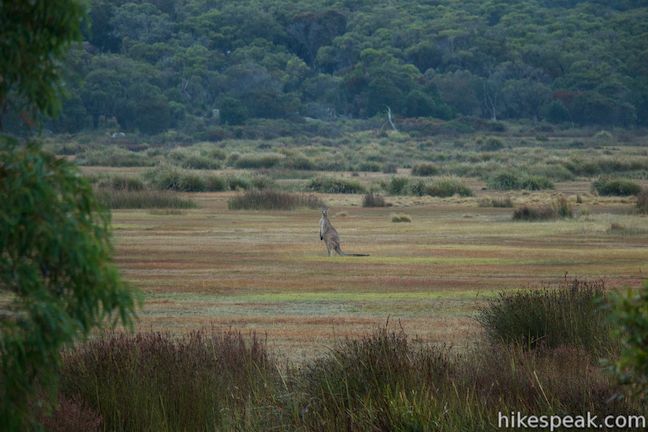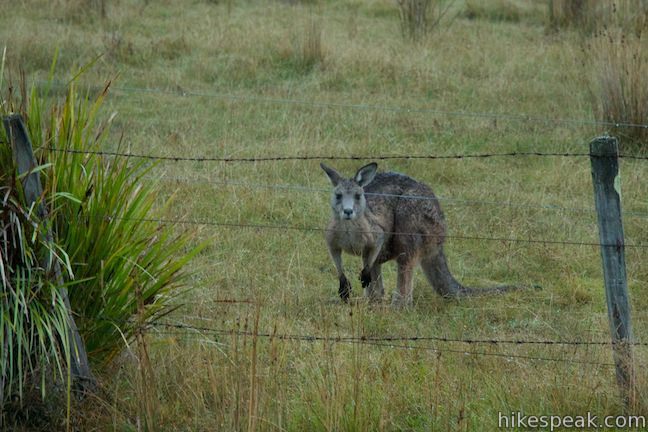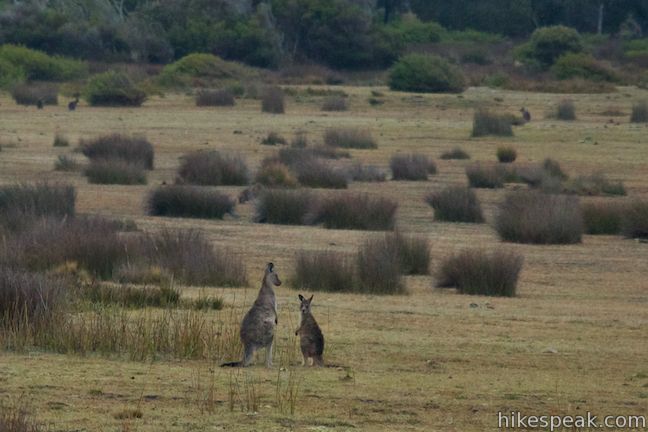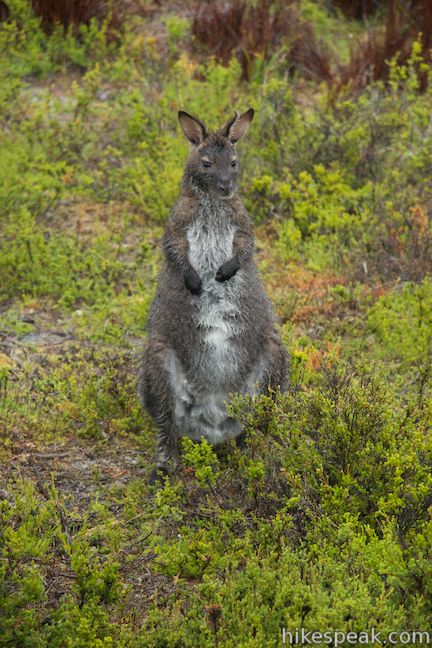Forester Kangaroo Drive
in Mount William National Park

The kangaroos and wallabies are everywhere! That’s what you’ll be saying if you travel along Forester Kangaroo Drive in Mount William National Park. At dawn and dusk these marsupials come out in droves to graze in the fields along this 11.25-kilometer (7-mile) long road. Forester Kangaroos are the only kangaroos in Tasmania, and this is one of the best places to see them, so hop to it!
Mount William National Park is located on the northeast tip of Tasmania and is one of the only places on the island where kangaroos can be seen. Forester Kangaroo Drive is an unsealed dirt road shaped like a horseshoe that connects to Musselroe Bay Road at both ends. The connecting section of Musselroe Bay Road combines with Forester Kangaroo Drive to form a 15.25-kilometer circuit. The best time to see these marsupials is in the early morning and late afternoon as the sun is rising and setting. This is when kangaroos and wallabies come out of the forest to graze in the grassland along the road. Drive slowly and keep on the lookout for kangaroos and wallabies, which will be all around you. The sign at the start of Forester Kangaroo Drive reads:
Mt William National Park provides a sanctuary for the forester kangaroo, Tasmania’s largest marsupial. The Forester prefers a habitat that includes open grassed areas surrounded by light forest. For this reason, several large areas of developed pasture have been incorporated into the park. These pastures are being maintained in this condition to support the kangaroo. It is in these paddocks, on each side of the drive, that you are likely to see kangaroos. Bennetts wallaby and wombats may also be seen. The best observations are made in the late afternoon.
Some kangaroos will be obvious, standing in the middle of grassy openings, while others will be hidden in the brush along the road. Often, kangaroos and wallabies will be bent over to nibble on grasses, but other times they will be standing up tall.
Forester kangaroos can be two meters tall and Bennetts wallabies can be 1.5 meters tall. When there are kangaroos and wallabies close to the road, stop your vehicle and get a good look. They will stand and stare at you and then suddenly decide to bolt and take off in a series of quick energetic bounces.

Starting from the north end of Forester Kangaroo Drive, you will come to a side road up to a vista point after 1.2 kilometers. Take this short road up onto a rise where there is a pavilion and a picnic table, along with views north over kangaroo-filled paddocks toward the ocean, where Flinders Island and Cape Barren Island can be seen.
Another turnoff is an additional 2.3 kilometers down Forester Kangaroo Drive. This road leads to Stumpys Bay Campground, where there is camping on the coast in Mount William National Park.
Continue along the drive for another 3.65 kilometers to come to another side road that leads to a walking track to the summit of Mount William, the highest point in the park. Each of these side roads will be on the left if you start from the north end of the road. It is another 4.1 kilometers on Forester Kangaroo Drive to reach the south end of the drive on Musselroe Bay Road.

A bit more about wallabies and kangaroos:
Forester kangaroos are the only species of kangaroos that live in Tasmania, which makes them the island’s largest marsupials. They are also the second biggest marsupials in the world and can weigh over 60 kilograms (130 pounds) and reach two meters (6.5 feet) tall when standing upright. The habitat for Forester kangaroos in Tasmania is limited, as the Parks and Wildlife Service explains on their Forester kangaroo webpage:
The Forester kangaroo is restricted to northeastern Tasmania and small areas in central Tasmania. The Mt William National Park in the northeast provides the opportunity to see these animals along ‘Forester Drive’. A drive, or stroll along this road at dusk is most rewarding. The Forester has also been introduced to Maria Island National Park and Narawntapu National Park. Preferred habitat is dry sclerophyll forest with open grassland clearings.

Bennets Wallabies can also be seen along Forester Kangaroo Drive and are easy to mistake for kangaroos. They are smaller and can weight over 20 kilograms (45 pounds) and reach 1.5 meters (almost 5 feet) tall when standing upright. To distinguish wallabies from kangaroos, look for their black nose and paws.

When you come to the end of Forester Kangaroo Drive, you might just want to drive it all over again. Many of the kangaroos and wallabies you see will be far off in the fields, or quickly jumping into the brush and out of sight, but others will be close to the road and stay still long enough for you to really watch them. If you are camping at Stumpys Bay, try walking along the road to see more wildlife without the disruptive noise of a vehicle.
A national park entrance fee is required to visit Mount William National Park. A single day pass will cost $40 or you may purchase an 8-week pass good for all of Tasmania’s National Parks for $80 (all prices in Australian Dollars as of 2021).
Directions: Take Tasman Highway (A3), 42 kilometers east of Scottsdale and 56 kilometers northwest of St. Helens to Gladstone Road (B82) and turn north following signs for Mount William National Park. Drive 25 kilometers to the small town of Gladstone and turn right on Carr Street/Cape Portland Road again following signs for the park (if you miss the intersection, you will quickly come to the end of the road). Drive two kilometers as the road becomes dirt and continue on to Browns Ridge Road/Musselroe Bay Road. Drive another 15.25 kilometers, going through a few twists and turn before entering the national park where you will find the south end of Forester Kangaroo Drive on the right. If you drive another 4 kilometers up Musselroe Bay Road, you will come to the other end of Forrester Kangaroo Drive
Scenic drive address: Forester Kangaroo Drive & Musselroe Bay Road, Mount William National Park, TAS 7264, Australia
Scenic drive coordinates: -40.891208, 148.163306 (40° 53′ 28.34″S 148° 09′ 47.90″E)
Use the map below to view the drive and get directions:
Or view Australian trails, campgrounds, and lodging in a larger map
 | Mount William This 3.6-kilometer out and back hike tops a short summit that is the high point of Mount William National Park with panoramic views over the coastline at the northeast corner of Tasmania. |
 | Saint Columba Falls This 1.2-kilometer round trip hike descends into a rainforest to the base of a powerful 90-meter tall waterfall. |
 | Apsley Waterhole & Lookout Track This 1.4-kilometer loop travels through a eucalyptus forest to a popular swimming hole on the Apsley River in Douglas-Apsley National Park. |
 | Friendly Beaches This hike explores a long, pristine beach on the east coast of Tasmania north of the Freycinet Peninsula. |
 | Cape Tourville This 0.6-kilometer circuit provides big views along the east coast of Freycinet Peninsula, circling 100-meter tall bluffs to reach the Cape Tourville Lighthouse. |
 | Wineglass Bay and Hazards Beach Circuit This approximately 12-kilometer loop takes a rewarding route through Freycinet National Park, visiting pristine light sand beaches at Hazards Beach and the renowned Wineglass Bay. |
 | Cataract Gorge This 3.4-kilometer loop combines Zig-Zag Track, Cataract Walk, and Bridge Walk to explore Cataract Gorge Reserve, an impressive natural area just outside the center of Launceston. |
 | Liffey Falls This 2.2-kilometer walk passes the Upper Cascades on the Liffey River to reach the base of lovely Liffey Falls, one of Tasmania’s finest waterfalls. |
 | Russell Falls & Horseshoe Falls This hike in Mount Field National Park visits one of Tasmania’s most famous and beautiful waterfalls and can be extended from 1.8 to 2.65 kilometers by venturing to the top of Russell Falls and nearby Horseshoe Falls. |
 | Pinnacles Boardwalk & Summit Trig The 0.3-kilometer round trip walk on Pinnacles Boardwalk can easily be extended to a 0.75-kilometer walk on the top of Mount Wellington, checking out another short boardwalk and the trig station at the summit. |
 | Octopus Tree and Circle Track This 1.1-kilometer loop in Hobart’s Wellington Park reaches a unique eucalyptus tree with tentacles for roots that wrap around a boulder. |
 | Tasmans Arch & Devils Kitchen This 0.9-mile walk visits two impressive features on the coast of the Tasman Peninsula, a natural bridge and a chasm carved by the sea. |
 | Blowhole & Fossil Bay Lookout This short walk in Tasman National Park reaches a coastal vista point and a wave-carved tunnel through a rocky point that has the potential to spray up like a whale spout. |
 | Coal Mines Historic Site This 0.8-kilometer loop through the Convict Precinct explores the ruins of an old prison and coal mine that relied on convict laborers. |
 | Cape Raoul This 12 to 14-kilometer hike explores the pristine coastline at the southwest end of the Tasman Peninsula, reaching a cape with daunting 200-meter tall cliffs dropping to swirling seas. |
 | More trails in Australia Explore other destinations in Victoria and Tasmania, Australia. |
 | Stumpys Bay Campground This campground is split into four areas along Stumps Bay with numerous campsite for visitors to Mount William National Park. |























